- Homepage
- South Indian Recipes
- Gluten free Neer Dose - Ghavan
Neer dosa - Ghavan Gluten free crepes recipe
Ghavan from Konkan in Maharashtra
Neer dosa or Neer
dosa, gluten free crepes recipe is a part of Southern Karnataka
cuisine. It is also made in Konkan region of Maharashtra and is known as Ghavan.
Easy to make and filling, it needs few ingredients. It
can be served at breakfast as well as any other meal.
'Neer' means water in Kannada, Sanskrit languages. Neer dose literally means 'watery dosa'. The dosa batter is very thin and watery, hence the name.
In neerdosa from Karnataka, fresh grated coconut is added while grinding rice. In Maharashtrian ghavane, no fresh coconut is added. Both taste good and are easy to make.
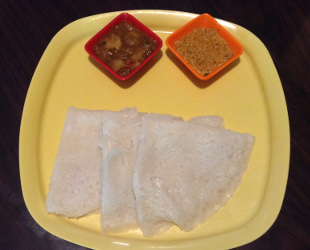 Neer dosa / Ghavan + chutney + curry
Neer dosa / Ghavan + chutney + curryAs these dosas are very thin, a person may eat 3-4 dosas.
Some South Indian restaurants serve this traditional dish as it is very popular. Neeru dosa batter needs no fermentation like the usual dosa batter. So it takes less time and preparation.
Neer dose can be served at room temperature. It is convenient when you want to serve to many people at the same time as you can make it in advance.
Neer dosa is soft and thin. If you like your dosas crisp and thick, you may not be so keen to try neer dosa. I assure you, you will change your mind once you try this neer dose.
I usually like my dosas crisp. So the first time I made this neer dose at my daughters suggestion, (she had tasted it at her friend's place), I was not very hopeful of liking this. But once I made this, the ease of making the dosa batter and the taste made me like these dosas.
If you have some curry leftover and are wondering what to eat it with, neeru dosa is the perfect accompaniment.
You may use any short grain raw rice in this recipe.
How to make neer dosa - Ghavan - Gluten free crepes
Ingredients for neer dose
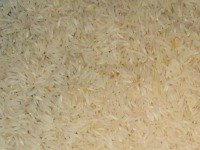 Raw rice
Raw rice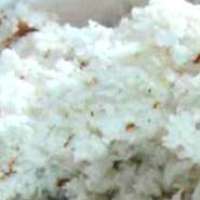 Fresh grated coconut
Fresh grated coconutIngredients for serving 2 persons
- Rice - 1 cup
- Fresh grated coconut(optional) - 1/4 cup
- Salt - 1/2 tsp or according to taste
- Water - 3 cups, more or less as needed.
Preparation before making neer dose
-
Wash rice till water runs clean. Soak rice for minimum 4 hours. Overnight soaking is ok.
- Add soaked rice to the mixer jar. Grind rice and grated coconut (if adding) till it is
very smooth. First grind with a little water. Add more water for grinding as needed. There should not be
any grains remaining. The texture of the batter should be very smooth.
- Take out the batter in a bowl. Add salt according to taste.
- Add more water if needed. The consistency of the batter should be like milk.
- Your neer dose/ ghavan batter is ready.
The first one or two dosas will tell you if your batter is of right consistency.
- Heat a seasoned tava / nonstick flat pan. Once the pan is heated, keep the flame medium.
- Spread a little oil on the tava. Stir the batter and pour a laddleful of batter on the tava.
- You may pour the batter on the tava or tilt the tava in circular motion to spread the batter in a circle. As the batter is watery, it should spread easily. If it doesn't spread easily, add a little more water for the next dosa.
- You may cover the pan or leave it open. Covering up may cook the dosa fast and will keep it soft. I usually cover it with a lid.
- Once the top of dosa looks cooked (it will change color from pure
white to dull white) and dry, try to lift at the edges of the dosa.
- When you can easily lift it, fold it in half and then in to quarter (if you wish).
- There is no need to flip it and cook on the other side but if you wish, you may cook the other side for a few seconds.
- Take out on a plate or in a wide container with lid.
Keep covered till serving time. Or you may serve it immediately.
Make all the dosas in the same way. Remember to stir the batter every time you take out a laddleful of batter. Neer dosa tastes good even at room temperature.
Serving suggestions for neer dosa - Gluten free crepes
- Serve neer dosa with coconut chutney or curry leaf chutney or any other chutney of your choice.
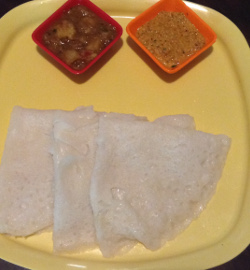
- It also tastes good with curries such as bombay potato saagu, veg curry , avial etc.
- You may serve a little ghee, butter or plain yogurt with this dosa.
- Serve it with your favorite pickle or dry chutney powder.
- If you like it, serve it with a favorite jam or marmalade.
- You may stuff these crepes with chopped bananas with a little honey. Tastes wonderful.
Tips for making neer dosa / ghavane:
This dosa does not stick to the pan when the batter consistency is right and the pan is well heated.
If it sticks, check your batter consistency. You may need to add more water.
Traditionally these dosas are white in color. Even when they brown, they taste great. They may brown if your tava is too hot or you have cooked them longer than necessary. I like them a bit browned.
Stir the batter before making every dosa. The rice flour tends to settle at the bottom of the bowl.
You may or may not add a few drops of oil on the sides of dosa.
Usually these dosas do not stick to the pan and do not need added oil, but the choice is yours. Oil adds to the taste.
Instead of fresh grated coconut, you may add coconut milk, in powder or liquid form, to the batter.
If you do not wish to go
through the hassle of soaking and grinding rice, you may use the ready
rice flour available to make the batter in the similar way and make neer
dosa but the taste and the softness of the dosa may differ.
Make sure, the batter is not lumpy which ever way you make neer dosa.
Making neer dosa with ready rice flour
When you do not have time or do not wish to go through the hassle of soaking, grinding rice for neer dosa, you may use the ready rice flour available in shops. The method is given here.
Ingredients for making neerdosa with rice flour
- Rice flour - 1 cup
- Salt - 1/4 tsp or according to taste
- Water as needed
- Fresh grated coconut (optional) - 2 tbsp
Making rice flour neer dosa
If you are not using coconut, you may just mix rice flour with water to form a thin lump less batter. Or
If you are using grated coconut, Take rice flour and fresh grated coconut in the mixer jar. Grind with water till smooth batter is formed.
Add salt and keep the batter aside for 20-30 minutes and then make dosas as given above.
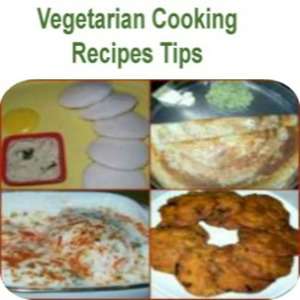


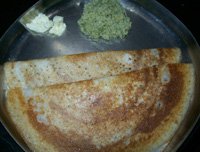
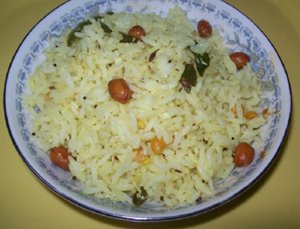
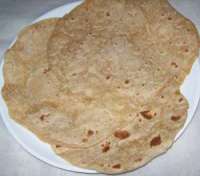
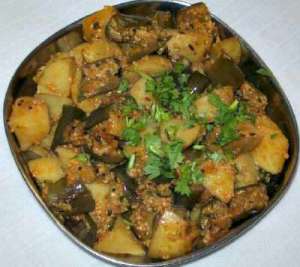
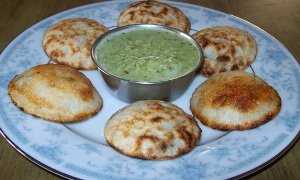
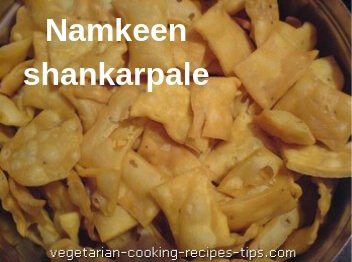
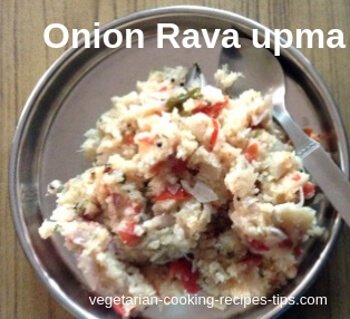
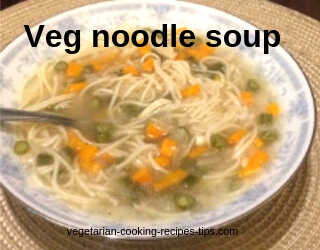
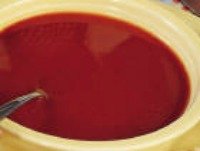
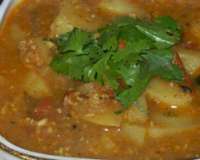

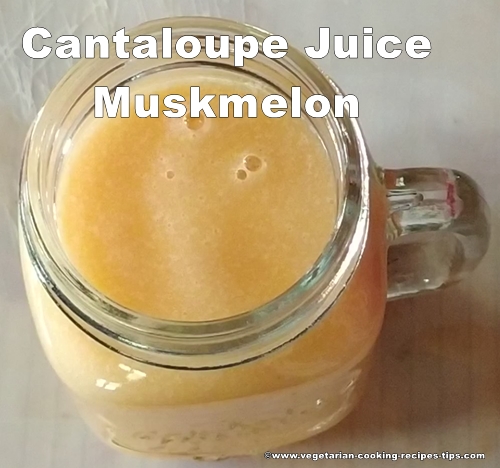


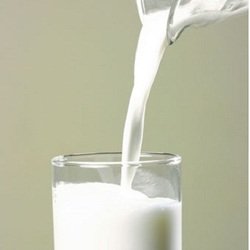
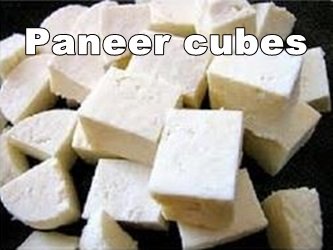
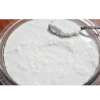

New! Comments
Have your say about what you just read! Leave me a comment in the box below.